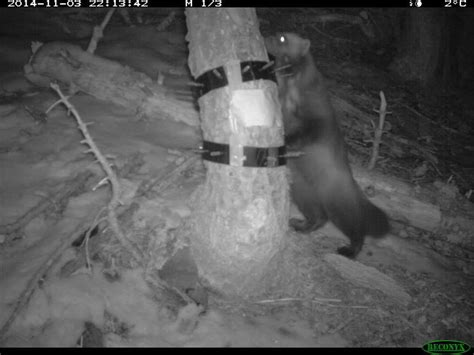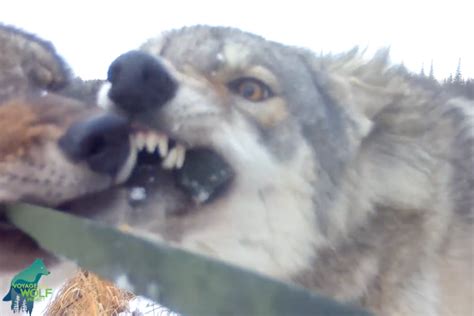
Wolverine wanders far south, stunning wildlife experts after trail cameras capture rare footage of the elusive creature in Yosemite National Park, marking one of the southernmost confirmed sightings of the animal in recent history.
Yosemite National Park – An exceptionally rare wolverine sighting has been confirmed in Yosemite National Park, California, thanks to the diligent work of park biologists and strategically placed trail cameras. The remarkable footage, captured in remote areas of the park, showcases a wolverine venturing significantly further south than its typical range, generating excitement and prompting further research into the animal’s movements and habitat use. The sighting, confirmed this week, marks only the third documented wolverine observation in Yosemite since 1916, underscoring the rarity and significance of the event.
“We are thrilled to confirm the presence of a wolverine in Yosemite National Park,” stated park spokesperson Jamie Richards in a press release. “This sighting is a testament to the park’s commitment to wildlife conservation and the effectiveness of our monitoring programs.”
The wolverine, a member of the weasel family and known for its solitary nature and fierce reputation, typically inhabits high-elevation alpine and subalpine regions. Their range in the contiguous United States is primarily confined to the northern Rocky Mountains, the North Cascades, and occasionally the Sierra Nevada. The recent Yosemite sighting pushes the known southern boundary of their distribution, raising questions about the factors driving this dispersal.
According to park biologists, the wolverine was first detected through a series of strategically placed trail cameras used to monitor wildlife activity in remote regions of Yosemite. The cameras captured several images and video clips of the animal over a period of several weeks, allowing researchers to confirm its identity and track its movements.
“The trail camera footage is remarkable,” said Dr. Sarah Martinez, a wildlife biologist with Yosemite National Park. “It clearly shows a wolverine exhibiting its characteristic behavior. We are working to gather more information about this individual and its potential impact on the park’s ecosystem.”
The confirmation process involved a thorough review of the images and videos by wolverine experts, who analyzed physical characteristics, movement patterns, and habitat use to rule out other potential species. The distinctive dark brown fur, stocky build, and characteristic gait of the wolverine were key identifiers.
“Wolverines are incredibly elusive animals,” explains Dr. Emily Carter, a wolverine specialist at the Wildlife Conservation Society, who reviewed the footage. “To get such clear images and videos is truly exceptional. It provides us with valuable insights into their behavior and distribution.”
The last confirmed wolverine sighting in Yosemite National Park occurred in 2009, and prior to that, in 1916. This infrequency highlights the rarity of these animals in the region and underscores the importance of ongoing monitoring efforts. The 2009 sighting was particularly significant as it marked the first confirmed wolverine presence in the park in nearly a century. DNA analysis of hair samples collected at the time revealed that the animal was likely a male and not related to wolverines previously identified in other parts of the Sierra Nevada.
The recent sighting has triggered a renewed focus on wolverine research and conservation efforts in Yosemite National Park. Park biologists are collaborating with researchers from other institutions to study the wolverine’s habitat use, diet, and potential interactions with other wildlife species. They are also working to assess the carrying capacity of the park for wolverines and to identify potential threats to their survival.
One of the key challenges in wolverine conservation is the animal’s low population density and wide-ranging movements. Wolverines require large, undisturbed areas of habitat to survive, and they are particularly sensitive to habitat fragmentation and human disturbance. Climate change also poses a significant threat to wolverines, as rising temperatures and declining snowpack can reduce the availability of suitable habitat and prey.
“Climate change is a major concern for wolverine conservation,” said Dr. Martinez. “As the climate warms, we expect to see further reductions in snowpack and changes in vegetation patterns, which could impact wolverine habitat.”
In response to these challenges, Yosemite National Park is implementing a range of conservation measures to protect wolverines and their habitat. These measures include:
- Habitat protection: Designating critical wolverine habitat areas and restricting development and other activities that could degrade habitat quality.
- Monitoring: Continuing to use trail cameras and other monitoring techniques to track wolverine populations and movements.
- Research: Conducting research to better understand wolverine ecology and the threats they face.
- Education: Educating the public about wolverines and the importance of their conservation.
- Collaboration: Working with other agencies and organizations to coordinate wolverine conservation efforts across the region.
The recent wolverine sighting in Yosemite National Park serves as a reminder of the importance of protecting biodiversity and preserving wild landscapes. Wolverines are an iconic symbol of the wilderness, and their presence in Yosemite is a testament to the park’s ecological integrity. By continuing to invest in conservation efforts, we can ensure that these magnificent animals continue to roam the Sierra Nevada for generations to come.
The sighting also underscores the role of technology in wildlife monitoring and conservation. Trail cameras have become an indispensable tool for biologists, allowing them to study elusive and wide-ranging species in their natural habitat. The cameras are equipped with motion sensors that trigger when an animal passes by, capturing images and videos that can be used to identify species, track movements, and assess population sizes.
“Trail cameras have revolutionized wildlife monitoring,” said Dr. Carter. “They allow us to collect data on species that would be nearly impossible to study otherwise.”
The data collected from trail cameras can be used to inform conservation decisions, such as identifying critical habitat areas, assessing the impact of human activities on wildlife populations, and monitoring the effectiveness of conservation measures.
The discovery of the wolverine in Yosemite National Park has not only excited the scientific community but also captured the public’s imagination. The image of this resilient creature thriving in a challenging environment resonates with many people, reminding them of the importance of preserving our natural heritage.
As Yosemite National Park continues its efforts to protect wolverines and other wildlife species, it is hoped that this sighting will inspire others to support conservation efforts and to appreciate the value of wild places. The presence of the wolverine in Yosemite is a sign of hope for the future, demonstrating that even in the face of environmental challenges, nature can still surprise and inspire us.
The significance of the wolverine sighting extends beyond the boundaries of Yosemite National Park. It highlights the importance of maintaining connectivity between protected areas, allowing wildlife to move freely and adapt to changing environmental conditions. The Sierra Nevada is a critical corridor for wildlife movement in California, and the presence of wolverines in Yosemite underscores the need to protect this corridor from habitat fragmentation and other threats.
Furthermore, the sighting raises important questions about the role of climate change in driving species distribution shifts. As the climate warms, many species are shifting their ranges in search of suitable habitat. The wolverine’s presence in Yosemite may be an indication that the species is expanding its range in response to climate change.
Understanding how species are responding to climate change is crucial for developing effective conservation strategies. By studying the movements and habitat use of wolverines and other climate-sensitive species, we can better anticipate future changes and develop strategies to help them adapt.
The Yosemite National Park’s continued monitoring efforts, combined with collaborative research and proactive conservation measures, offer a beacon of hope for the future of wolverines in the Sierra Nevada. The recent sighting serves as a powerful reminder of the enduring resilience of nature and the importance of preserving our planet’s biodiversity.
The wolverine’s story in Yosemite is far from over. As researchers continue to study this elusive animal, we can expect to learn more about its ecology, behavior, and the challenges it faces. By working together, we can ensure that wolverines continue to roam the Sierra Nevada for generations to come, enriching the natural heritage of California and inspiring future generations to appreciate the value of wild places.
The park encourages visitors to report any potential wolverine sightings to park authorities, providing details such as location, date, time, and any photographic evidence. However, visitors are reminded to maintain a safe distance from wildlife and to avoid disturbing their natural habitat.
The long-term implications of this sighting are significant. If wolverines are establishing a more permanent presence in Yosemite, it could have cascading effects on the park’s ecosystem. Understanding these effects will require ongoing research and monitoring.
Additional Contextual Information:
Wolverines are the largest member of the weasel family, renowned for their strength, resilience, and solitary nature. They typically inhabit remote, high-elevation areas with cold climates and abundant snow cover. Their thick fur and large paws allow them to navigate deep snow and withstand harsh winter conditions.
Wolverines are opportunistic scavengers and predators, feeding on a variety of animals, including rodents, birds, and ungulates. They are also known to scavenge on carrion, playing an important role in the ecosystem by cleaning up carcasses and preventing the spread of disease.
Historically, wolverines were more widely distributed throughout the western United States. However, due to trapping, hunting, and habitat loss, their range has been significantly reduced. Today, wolverines are found primarily in the northern Rocky Mountains, the North Cascades, and occasionally the Sierra Nevada.
The wolverine is currently listed as a threatened species under the Endangered Species Act in the contiguous United States. The U.S. Fish and Wildlife Service has determined that climate change poses a significant threat to wolverines, as rising temperatures and declining snowpack could reduce the availability of suitable habitat and prey.
The conservation of wolverines requires a multi-faceted approach, including habitat protection, monitoring, research, education, and collaboration. By working together, we can ensure that these magnificent animals continue to thrive in the wild.
Detailed Habitat and Range Information:
Wolverines are adapted to survive in some of the most challenging environments on Earth. They prefer high-elevation alpine and subalpine areas with abundant snow cover, which provides insulation and access to prey. In the contiguous United States, their primary habitat is located in the northern Rocky Mountains (Montana, Idaho, Wyoming), the North Cascades (Washington), and, sporadically, in the Sierra Nevada (California).
The Sierra Nevada population is particularly vulnerable due to its isolation and small size. Habitat fragmentation and climate change pose significant threats to this population. As the climate warms, snowpack is declining, and vegetation patterns are changing, which could reduce the availability of suitable wolverine habitat.
Wolverines require large, undisturbed areas of habitat to survive. They are solitary animals and typically maintain large home ranges, which can range from several hundred to several thousand square kilometers. These large home ranges allow them to access sufficient food resources and to avoid competition with other wolverines.
The quality of wolverine habitat is determined by a variety of factors, including snow cover, vegetation type, and the availability of prey. Wolverines prefer areas with deep, persistent snow cover, which provides insulation and access to denning sites. They also prefer areas with a mix of forest and open areas, which provides a variety of foraging opportunities.
The presence of prey is also a critical factor in determining wolverine habitat quality. Wolverines feed on a variety of animals, including rodents, birds, and ungulates. They are also known to scavenge on carrion, which can be an important food source during the winter months.
The conservation of wolverine habitat requires a comprehensive approach that considers the needs of the species and the threats they face. Habitat protection, restoration, and management are essential for ensuring the long-term survival of wolverines.
The Role of Trail Cameras in Wildlife Conservation:
Trail cameras have become an indispensable tool for wildlife biologists, providing a non-invasive way to study elusive and wide-ranging species. These cameras are equipped with motion sensors that trigger when an animal passes by, capturing images and videos that can be used to identify species, track movements, and assess population sizes.
Trail cameras are particularly useful for studying wolverines, as these animals are difficult to observe directly due to their solitary nature and remote habitat. By placing trail cameras in strategic locations, biologists can collect valuable data on wolverine populations without disturbing the animals.
The data collected from trail cameras can be used to inform conservation decisions, such as identifying critical habitat areas, assessing the impact of human activities on wildlife populations, and monitoring the effectiveness of conservation measures.
In the case of the Yosemite wolverine sighting, trail cameras played a crucial role in detecting the animal and confirming its presence in the park. The images and videos captured by the cameras provided irrefutable evidence of the wolverine’s presence, allowing biologists to launch a more detailed investigation.
As technology continues to advance, trail cameras are becoming even more sophisticated. Some cameras are now equipped with GPS tracking devices, which allow biologists to monitor the movements of individual animals in real-time. Others are equipped with infrared sensors, which allow them to capture images and videos in complete darkness.
Trail cameras are an essential tool for wildlife conservation, providing valuable data that can be used to protect and manage wildlife populations.
The Impact of Climate Change on Wolverines:
Climate change poses a significant threat to wolverines, as rising temperatures and declining snowpack could reduce the availability of suitable habitat and prey. Wolverines are adapted to survive in cold, snowy environments, and they rely on snow cover for insulation, access to denning sites, and foraging opportunities.
As the climate warms, snowpack is declining, and vegetation patterns are changing, which could reduce the amount of suitable wolverine habitat. In some areas, snowpack is already declining significantly, and scientists predict that these declines will continue in the future.
The loss of snowpack could have a number of negative impacts on wolverines. It could reduce the availability of denning sites, as wolverines typically den in snow caves. It could also reduce the availability of prey, as some of the animals that wolverines feed on rely on snow cover for survival.
In addition to the direct impacts of climate change on wolverine habitat, there are also indirect impacts that could affect wolverine populations. For example, climate change could lead to an increase in the frequency and intensity of wildfires, which could destroy wolverine habitat. It could also lead to an increase in the spread of invasive species, which could compete with wolverines for resources.
The conservation of wolverines in the face of climate change requires a proactive approach that addresses both the direct and indirect impacts of climate change. This includes protecting and restoring wolverine habitat, reducing greenhouse gas emissions, and mitigating the impacts of climate change on wolverine populations.
FAQ Section:
1. What is a wolverine and why is this sighting significant?
A wolverine ( Gulo gulo ) is the largest member of the weasel family. It’s a solitary and powerful animal adapted to cold, snowy environments. This sighting is significant because wolverines are rare in California, particularly so far south in the Sierra Nevada. It’s only the third confirmed sighting in Yosemite National Park since 1916. This suggests potential range expansion or dispersal, prompting further investigation.
2. Where are wolverines typically found in the United States?
Wolverines typically inhabit high-elevation alpine and subalpine regions with abundant snow cover. In the contiguous United States, their range is primarily confined to the northern Rocky Mountains (Montana, Idaho, Wyoming), the North Cascades (Washington), and occasionally the Sierra Nevada (California).
3. How was the wolverine sighting in Yosemite confirmed?
The wolverine was detected through strategically placed trail cameras used to monitor wildlife activity in remote areas of Yosemite National Park. The cameras captured images and video clips of the animal over several weeks. Wolverine experts then reviewed the footage, analyzing physical characteristics, movement patterns, and habitat use to confirm the animal’s identity.
4. What threats do wolverines face, and what is being done to protect them?
Wolverines face several threats, including habitat loss and fragmentation, human disturbance, and climate change. Rising temperatures and declining snowpack, driven by climate change, can reduce the availability of suitable habitat and prey. Yosemite National Park is implementing conservation measures such as habitat protection, monitoring, research, education, and collaboration with other agencies to protect wolverines.
5. What should I do if I think I see a wolverine in Yosemite National Park?
The park encourages visitors to report any potential wolverine sightings to park authorities. Provide as much detail as possible, including the location, date, time, and any photographic evidence. Remember to maintain a safe distance from the animal and avoid disturbing its natural habitat.









